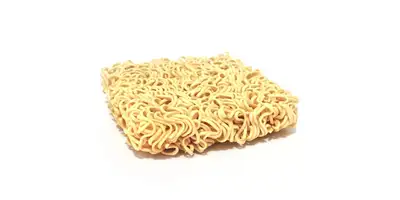
Every day we hear something new about nutrition. With information coming at us from all directions, it often seems that one day something is good for you, but...
Read more


|
Nutrient |
Per 100 g |
|---|---|
|
Calorific value |
1440 kJ |
|
Energy |
344 kcal |
|
Carbohydrates |
72 g |
|
Protein |
10 g |
|
Fat |
1 g |
The food Mie noodles (raw) is composed of the following macronutrients.
Mie noodles are a type of Asian noodles made from wheat flour and used in many Asian cuisines. Here are some advantages of Mie noodles:
Mie noodles are generally elongated, thin and smooth and are commonly used in soups, stews and fried noodle dishes.
Mie noodles originated in China and are now eaten in many parts of Asia, including Indonesia, Thailand, Vietnam and Japan. They are also available in many other parts of the world and are often sold in Asian restaurants and supermarkets.
Mie noodles are usually made from wheat flour, water, and an emulsifier such as egg or sweet potato. They are very versatile and can be used in many different dishes.
Are there any special storage and shelf life requirements for Mie Noodles and what is the best way to store them?
Mie noodles should be stored in a cool, dark place to reduce the risk of mold growth and spoilage. A refrigerator temperature of about 4-5 °C is ideal. They should also be stored in airtight containers to protect them from moisture. Likewise, they should be protected from direct sunlight, as this can affect the quality of the pasta.
What are the possible risks of eating Mie noodles and how to avoid them?
Some people are allergic to wheat or other ingredients found in Mie noodles. If you are allergic to wheat or other ingredients, you should avoid Mie Noodles or seek medical advice before eating them. Because Mie Noodles are made from wheat flour, they contain gluten. People suffering from celiac disease or other gluten intolerance should avoid Mie Noodles or seek medical advice before consumption.
I love this app! The food is super varied and filling (and soo delicious!). With one purchase I have the ingredients for a whole week together, thanks to the shopping list. The ingredients are also readily available and not really expensive.
Nicole — App User
The first app in the field of nutrition tips that really convinces me. Updates get minor issues out of the way and new features are added all the time. Top!
Unknown user — App User
ave already tried many nutrition apps but here it is really great and you save a lot of time because you do not have to enter all the meals yourself! 👍👏
Mareen — App User
I don't usually rate apps but this one has to be rated.... I have never had such a great app just fits everything.... The nutrition plans are just absolutely awesome just everything is awesome many many thanks
Mareen — App User
This app is an excellent support for healthy eating even with little time and effort! Super recipes are also included. Highly recommended!
Lennert — App User